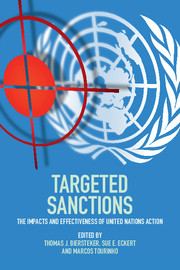Book contents
- Frontmatter
- Contents
- List of figures
- List of tables
- List of contributors
- List of abbreviations
- Introduction
- 1 Thinking about United Nations targeted sanctions
- 2 The purposes of targeted sanctions
- 3 Security Council dynamics and sanctions design
- 4 United Nations targeted sanctions and other policy tools: diplomacy, legal, use of force
- 5 The relationship between United Nations sanctions and regional sanctions regimes
- 6 Coordination of United Nations sanctions with other actors and instruments
- 7 Implementation of United Nations targeted sanctions
- 8 The impacts of United Nations targeted sanctions
- 9 The unintended consequences of United Nations targeted sanctions
- 10 The effectiveness of United Nations targeted sanctions
- 11 Institutional learning in targeting sanctions
- 12 Conclusion
- Appendix 1 List of cases and episodes
- Appendix 2 Sanctions effectiveness
- Appendix 3 TSC database codebook
- Appendix 4 Targeted Sanctions Consortium (TSC) participants
- Bibliography
- Index
4 - United Nations targeted sanctions and other policy tools: diplomacy, legal, use of force
Published online by Cambridge University Press: 05 March 2016
- Frontmatter
- Contents
- List of figures
- List of tables
- List of contributors
- List of abbreviations
- Introduction
- 1 Thinking about United Nations targeted sanctions
- 2 The purposes of targeted sanctions
- 3 Security Council dynamics and sanctions design
- 4 United Nations targeted sanctions and other policy tools: diplomacy, legal, use of force
- 5 The relationship between United Nations sanctions and regional sanctions regimes
- 6 Coordination of United Nations sanctions with other actors and instruments
- 7 Implementation of United Nations targeted sanctions
- 8 The impacts of United Nations targeted sanctions
- 9 The unintended consequences of United Nations targeted sanctions
- 10 The effectiveness of United Nations targeted sanctions
- 11 Institutional learning in targeting sanctions
- 12 Conclusion
- Appendix 1 List of cases and episodes
- Appendix 2 Sanctions effectiveness
- Appendix 3 TSC database codebook
- Appendix 4 Targeted Sanctions Consortium (TSC) participants
- Bibliography
- Index
Summary
The interaction between sanctions and other policy instruments is alluded to or explicitly mentioned in some existing work on sanctions. For example, Cortright and Lopez refer to it in their prescriptions on ‘Setting the Policy Framework’. Hufbauer, Schott, Elliott, and Oegg's analysis uses sender state's or coalitions’ ‘companion policies’ as a variable, while Doxey refers to senders’ ‘complementary strategies’ to sanctions.
The Targeted Sanctions Consortium data set allows further study of this issue, of which this chapter is an initial attempt. It is divided in two sections. The first addresses some general questions about the interaction between targeted sanctions and other policy instruments. The second section looks more closely at how UN targeted sanctions have interacted with force, diplomacy and negotiation, and judicial processes.
General questions: what, when, and why?
This section looks at three questions in order to identify general patterns in the interaction between targeted sanctions and other policy instruments:
(a) Which other policy instruments accompany targeted sanctions, and how often?
(b) Are sanctions’ effectiveness affected by the number of accompanying policy tools?
(c) To what extent does the Security Council rely on targeted sanctions, as opposed to other policy instruments, in pursuing its policy goals?
Other policy instruments
The data set shows that UN targeted sanctions have been used alongside twelve other policy instruments that seek, in the main, to achieve similar or related policy objectives: threats of and actual use of force (limited strikes, robust military force, no-fly zones, and naval blockades); peacekeeping; DDR; covert action (cyber-sabotage and targeted assassinations); legal processes (the ICC, the ICJ, and other tribunals); and negotiations and diplomacy. This is variously seen in all of the data set's twenty-three targeted sanctions country regimes and sixty-three episodes.
Frequency
In no episode are UN targeted sanctions used alone. They are always accompanied by at least one other policy instrument. The extent to which this reflects purposeful Security Council decision-making is addressed later in the chapter. But for now it is sufficient to note that, to date, UN targeted sanctions are always a complement to, or are complemented by, other policy tools.
Targeted sanctions most frequently accompany negotiations and diplomacy. This occurs in 97 per cent of the sanctions episodes. The second most frequent combination is with peacekeeping, in around 62 per cent of episodes.
- Type
- Chapter
- Information
- Targeted SanctionsThe Impacts and Effectiveness of United Nations Action, pp. 79 - 100Publisher: Cambridge University PressPrint publication year: 2016
- 2
- Cited by



